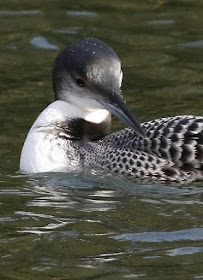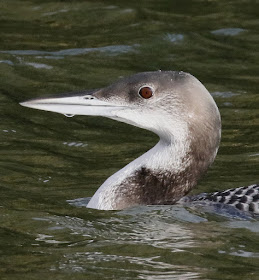Today I drove the length of the county, from my home in the extreme northwest of Oxfordshire, south to Beale Park which lies by the River Thames just in Berkshire, the river hereabouts forming the county line between Berkshire and Oxfordshire.
It took about an hour to drive to Beale Park and my reason for going was to see a juvenile Great Northern Diver that was first found on a lake just a few metres adjacent to the river but latterly has taken an apparent preference for the river and is to be found anywhere along an approximate mile stretch of the river either side of Beale Park and is easily viewable from the grass towpath that runs beside the river.
In pleasant sunshine but chastened by a raw and cold wind I left the car at a deserted and closed Beale Park at just after twelve noon, and made my way along a muddy track, past the lake to the flat grassy towpath. In direct contrast the opposite bank of the river, in Oxfordshire, rose steeply, a thickly wooded slope ascending to the skyline.
The river at this time of year is relatively undisturbed compared to the plethora of craft that take to it in the summer months and similarly the towpath was free of much disturbance. I encountered just a couple of local birders and a dog walker during my two hour visit. This lack of disturbance probably encouraged the diver to frequent the river where the fishing was possibly better than on the lake.
On reaching the river bank I was very fortunate to immediately come across the diver swimming in the middle of the river, diving for food and, due to its location, currently in Berkshire. I followed it, as by means of a series of leisurely dives, and exhibiting some interesting behaviour, it slowly moved downriver, in the direction of the town of Pangbourne and thus deeper into Berkshire.
 |
| River Thames dividing Berkshire from Oxfordshire |
On reaching the river bank I was very fortunate to immediately come across the diver swimming in the middle of the river, diving for food and, due to its location, currently in Berkshire. I followed it, as by means of a series of leisurely dives, and exhibiting some interesting behaviour, it slowly moved downriver, in the direction of the town of Pangbourne and thus deeper into Berkshire.
 |
| Maybe a touch of indigestion? |
 |
| Note how low in the water it can sink its body.The water is literally washing over its body behind its neck |
 |
| 'Snorkelling' where it swam along on the surface looking below the water for any likely fish to catch |
The diver continued feeding for the entire two hours I observed it and on two occasions I saw, what was for me, a unique event, although subsequent research on my part has shown it is not so unusual. I have watched countless Great Northern's diving and fishing and they always seem to consume their prey underwater before surfacing but twice this diver brought a large fish to the surface in order to deal with it and then swallow it. The first fish was a Tench, judging by the fins and the diver took some time to manouevre it into its bill in order to swallow the fish head first.The second fish was a Pike which looked a little on the large size but this I believe went down the same way as the Tench
 |
| The above two images are of the diver swallowing a Tench |
 |
| Here the diver has caught a Pike. |
 |
| A spot of feather maintenance. Note the length of its body |
 |
| Preening and showing the intricate scaly patterning of juvenile feathers on its mantle and wing coverts |
 |
| Watching a small aircraft passing over |
I watched this large bird, its size making its movements when resting on the water's surface almost ponderous although it is supremely adapted to a virtually exclusive aquatic existence. It has a formidable sized bill that is long, dagger shaped and at this time of year pale grey, requiring a large head and powerful neck to support it. The forehead has a curious ridge of feathers that is very distinctive and looks like a large bump when seen sideways on.
The diver's long, flat, torpedo shaped body can be held low in the water, so low that water sometimes flows over its back where it joins the neck and the diver and water become almost as one. The legs and feet are placed very far back, almost at the end of its body to give it the power to propel itself rapidly as it hunts its prey underwater.
This bird is a juvenile, as are most that are found inland, told by the prominent scaling all over the upperparts, each feather immaculate and precisely aligned with its neighbour. Its eyes, prominent in a pale face, shone ruby red in the bright sunshine and it will be two years before it reaches maturity and commences to breed.
The diver's long, flat, torpedo shaped body can be held low in the water, so low that water sometimes flows over its back where it joins the neck and the diver and water become almost as one. The legs and feet are placed very far back, almost at the end of its body to give it the power to propel itself rapidly as it hunts its prey underwater.
This bird is a juvenile, as are most that are found inland, told by the prominent scaling all over the upperparts, each feather immaculate and precisely aligned with its neighbour. Its eyes, prominent in a pale face, shone ruby red in the bright sunshine and it will be two years before it reaches maturity and commences to breed.
There were many alder trees growing in wetter parts of the hinterland between the towpath and the lake, their twiggy upper branches thick with plump catkins still maintaining a solid and unopened compactness, but it will not be long before they burst and these had attracted half a dozen Siskins, the males already commencing to sing. A couple of Lesser Redpolls were an unexpected find, rising up into the sky with their distinctive calls, from a birch tree.

















No comments:
Post a Comment